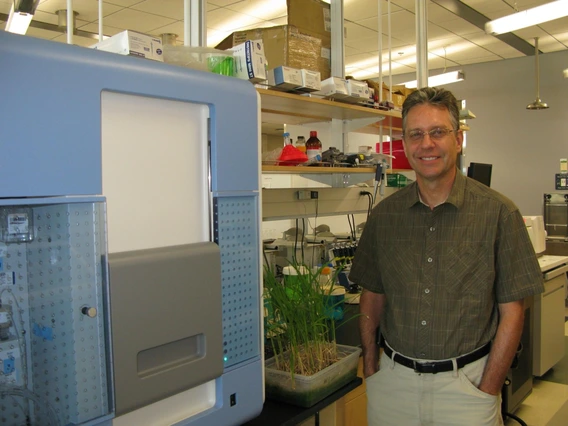Researchers to Sequence West African Rice Strain
UA and Tucson high school students will be involved in the research to help sequence the West African rice genome.
A $1.5 million grant from the National Science Foundation will allow University of Arizona researchers to unlock the genetic code of West African cultivated rice â and along the way to gain knowledge that could help commercial rice strains to better withstand dwindling resources, a changing climate and increased demand.
BIO5 Institute members Rod A. Wing, who holds the Bud Antle Endowed Chair for Excellence in Agriculture and Life Sciences, and Steve Rounsley, research professor of plant sciences, are co-primary investigators on the new grant. Wing previously took part in a six-year, $200 million project to sequence the genome of Asian cultivated rice.
Now, new techniques Wing and Rounsley have developed will allow them to sequence West African rice in only six months at a fraction of the cost.
"We'll be the first to so rapidly generate an extremely high quality genetic sequence, one that can be used forever to unravel the secrets of West African rice," Wing said.
Asian rice is the most common commercial rice crop and serves as a staple food in many countries. Since West African rice was originally cultivated under harsher conditions than Asian rice, it's better adapted to withstand hardships such as high temperatures and limited water.
Understanding the genes behind those adaptations could be a valuable first step in breeding new, hardier Asian strains as well â crucial work, given that the world's rice-dependent population is expected to double in the next 25 years.
Understanding both West African and Asian rice will also help researchers to better understand the whole process of domestication, or turning wild plants into food crops. That knowledge could also ultimately be used to improve the world's crops. "We'll be able to ask a lot of interesting questions about how two independent domestication events occurred," Rounsley explained. Â
Researchers at other institutions around the world are ready to use Wing and Rounsley's sequencing technique to sequence other rice relatives as well. They, as well as Wing and Rounsley, belong to an initiative known as the International Oryza Map Alignment Project (Oryza is the genus rice belongs to), or I-OMAP.
I-OMAP seeks to sequence all 23 rice species. "We're essentially trying to tear apart the whole genus, to understand it better and to come up with a parts list that can be used to design a greener rice," Wing said. "I'm optimistic that we can do this. I think we pretty much have to."
Wing, Rounsley, and the other I-OMAP researchers' work could ultimately also be applied to improving other domesticated grasses such as wheat, corn and sorghum.
"Rice is often used as a model for understanding how plants adapt to different environments," Rounsley said, because the rice genome is simpler than that of other crop plants. "Once you understand the genes in rice, you can do similar work with more difficult crops."
The grant has a strong outreach component â not only graduate and postdoctoral students, but also UA undergraduates and Tucson high school students will help sequence the West African rice genome.
Rounsley said they'll rely on existing BIO5 programs to bring in these students. "We wouldn't have been able to do it without BIO5," Rounsley said. "We're benefiting from our previous investment there." Both Wing and Rounsley see working with undergraduates and high school students as an important investment in training future researchers.
Those researchers will be needed, according to Wing and Rounsley. "We're all trying to solve a major world issue and prevent starvation in the future," Wing said. "This is a looming problem facing all of humankind."
Rounsley added, "By studying a variety of crops in a variety of environments all of agriculture can benefit. It's a matter of casting the net wide to get information about how plants deal with their environments, and then translating that into real applications."



